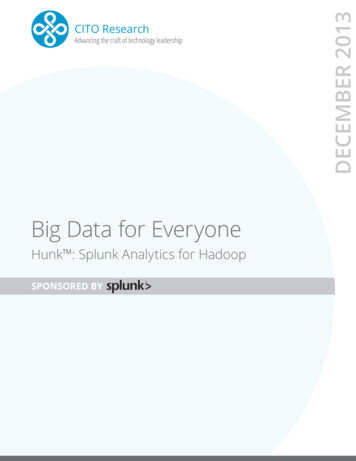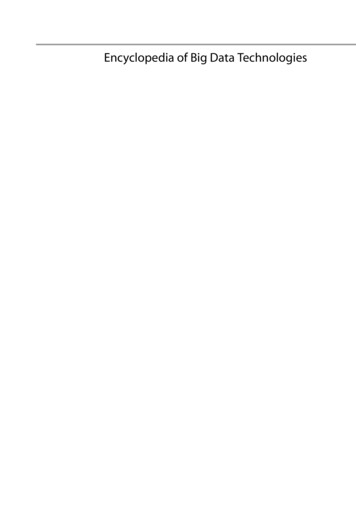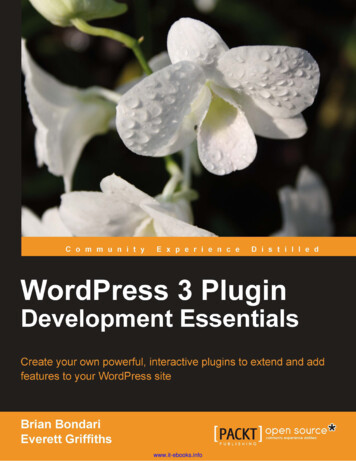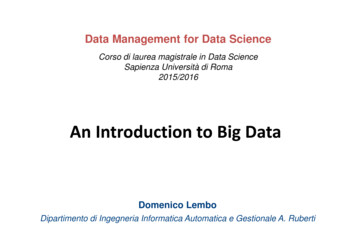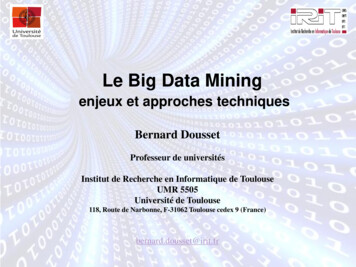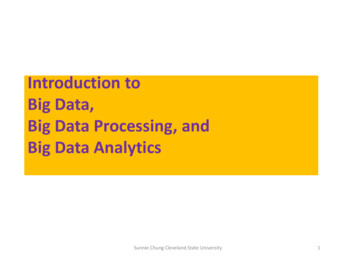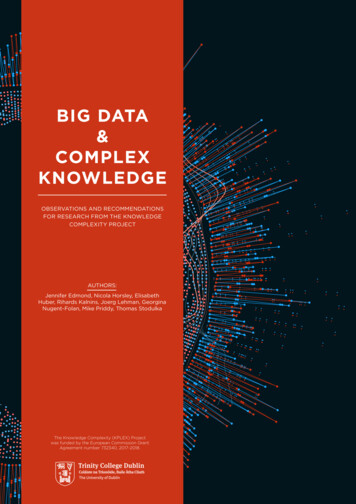
Transcription
BIG DATA&COMPLEXKNOWLEDGEOBSERVATIONS AND RECOMMENDATIONSFOR RESEARCH FROM THE KNOWLEDGECOMPLEXITY PROJECTAUTHORS:Jennifer Edmond, Nicola Horsley, ElisabethHuber, Rihards Kalnins, Joerg Lehman, GeorginaNugent-Folan, Mike Priddy, Thomas StodulkaThe Knowledge Complexity (KPLEX) Projectwas funded by the European Commission GrantAgreement number 732340, 2017-2018.1
TABLE OFCONTENTSI.INTRODUCTION: BIG DATA AND THE KNOWLEDGE COMPLEXITY PROJECT5II.WHO IS THIS DOCUMENT FOR?6III.INTEGRATED FINDINGS AND AREAS FOR FUTURE WORK8A. Big data is ill-suited to representing complexity: the urge toward easyinterrogability can often result in obscurity and user disempowerment.8B. Big data compromises rich information9C. Standards are both useful and harmful.9D. The appearance of openness can be misleading.10E. Research based on big data is overly opportunistic.11F. How we talk about big data matters.12G. Big data research should be supported by a greater diversity in approaches.13H. Even big data research is about narrative, which has implications for howwe should observe its objectivity or truth value.14I. The dark side of context: dark linking and de-anonymisation.15J. Organisational and professional practices.15K. Big data research and social confidence.16IV.RECOMMENDATIONS17V.IMPACT OF THE KPLEX PROJECT21
I. INTRODUCTION: BIG DATA AND THEKNOWLEDGE COMPLEXITY PROJECTThe Knowledge Complexity (or KPLEX) project was created with a two-foldpurpose: first, to expose potential areas of bias in big data research, and second,to do so using methods and challenges coming from a research communitythat has been relatively resistant to big data, namely the arts and humanities.The project’s founding supposition was that there are practical and culturalreasons why humanities research resists datafication, a process generallyunderstood as the substitution of original state research objects and processesfor digital, quantified or otherwise more structured streams of information. Theproject’s further assumption was that these very reasons for resistance couldbe instructive for the critical observation of big data research and innovationas a whole. To understand clearly the features of humanistic and cultural data,approaches, methodologies, institutions and challenges is to see the fault lineswhere datafication and algorithmic parsing may fail to deliver on what theypromise, or may hide the very insight they propose to expose. As such, the aimof the KPLEX project has been, from the outset, to pinpoint areas where differentresearch communities’ understanding of what the creation of knowledge is andshould be diverge, and, from this unique perspective, propose where furtherwork can and should be done.The KPLEX project team was recruited in such a way as to be create an experimentand a case study in interdisciplinary, applied research with a foundation in thehumanities. Each of the four partner research groups was drawn from a verydifferent research community, with different fundamental expectations of andfrom the knowledge creation process. The team of four partners includedresearch groups in both digital humanities and anthropology, a research dataarchive and an SME specialising in language technologies. This diversity was astrength of the project, but also a constant reminder of how challenging suchcooperative work, across disciplines and sectors, can be.Although the KPLEX project had only a short duration (15 months), its resultspoint toward a number of central issues and possible development avenuesfor a future of big data research that is socially aware and informed, but whichalso harnesses opportunities to explore new pathways to technical innovations.The challenges for the future of this research and for its exploitation will be toovercome the social and cultural barriers between the languages and practicesnot only of research communities, but also of the ICT industry and policysectors. The KPLEX results point toward clear potential value in these areas,for the uptake of the results, their application to meet societal challenges, andfor improving public knowledge and action. Such reuse, however, may takesignificant investment and time, so as to establish common vocabulary andoverturn long-standing biases and power dynamics, as will be described below.The potential benefits, however, could be great, in terms of technical, social andcultural innovation.5
II. WHO IS THIS DOCUMENT FOR?Given the broad aims and objectives of the project as defined in above, theresults and the example of the KPLEX project are of use to a wide variety ofpotential audiences.For researchers, the example of KPLEX has documented how high the impactcan be within a broadly interdisciplinary project, looking at technology bydrawing upon the perspectives of literary analysis, anthropology, library scienceand others. The techniques by which we have both differentiated and alignedour standpoints stands as a case study in the integration of approaches anddata across a number of potential fault lines. Research aiming to build uponKPLEX’s results will also be smoothly facilitated by the project’s open sharingof its research data.For policymakers, KPLEX has achieved its primary aim of creating an empiricalbasis that exposes sources of bias in big data research. Its results show, in anintegrated and holistic way, what issues might form a focus for future work,and what fissures might be approached, via regulatory, policy or practiceinterventions, to improve upon the current situation. Each of our thematiccases was defined to address a specific policy requirement currently visibleat European level: the need for more responsible approaches to funding thedevelopment of big data; the need to increase the possibility that culturaldata can be shared and reused effectively; the need to broaden the possiblepool of knowledge available to research and industry through the fostering ofopen science; and the need to contribute new insight to culturally sensitivecommunication tasks, as in multilingual environments. Work in each of theseareas will be able to draw from the KPLEX results.For the ICT industry and research, KPLEX’s results may at times seem challenging,but this alternative perspective should become a source of inspiration, rather thanfrustration. Software development exists in many ways as a distinct culture, withits own language, norms, values and hierarchies. As with any culture, these normsand values can provide a strong platform for creativity and development, butcan also prove a hindrance in situations that require translation and negotiationwith another such ‘culture’. At a time when the need for privacy preservationand a stronger ethical focus are becoming ever more widely recognised in ICTdevelopment and regulation, KPLEX’s results should be a welcome source offresh thinking. They can encourage deeper probing into fundamental areas ofresearch, such as managing uncertainty, supporting identity development, orexploring the unexpected impacts of digital interventions in society, all of whichmay be taken for granted in an innovation monoculture.6
KPLEX has developed a strong resonance with citizens, having attracted anumber of high-profile national broadcasters to feature the project. This is areflection not only of the quality and accessibility of the project, but also ofthe Zeitgeist in which it has been developed. People know enough about bigdata research to be concerned by it, but the inter-disciplinarity of KPLEX hasmade it a very fertile ground for public outreach, given that as multidisciplinaryresearchers in the KPLEX team, we cannot ourselves retreat to disciplinarynetworks and jargon to communicate our results.Finally, KPLEX has uncovered significant patterns in the organisational andinstitutional responses to the rapid changes being brought about by ICT, thegaps that are being left and the opportunities that are being found. Amongstresearchers and practitioners alike, KPLEX has discovered that the potentialgood of big data research is shadowed by real and justifiable feelings ofknowledge and perspectives being left behind, of being overwhelmed, of aloss of control and of diminishing authority for long-established practices andtheir underappreciated functions. As such, the project findings will be of useand interest to organisations struggling with technology adoption in the face ofrapid change on the one side and no decrease in the importance (and resourceintensity) of their pre-digital missions on the other.7
III. INTEGRATED FINDINGS AND AREASFOR FUTURE WORKThe KPLEX project was conceived of and organised according toa set of four themes: discourses of data, hidden data, human biasin data and the loss of cultural information in data. In the course ofresearching these themes, KPLEX mined the attitudes and opinions ofmany different researchers and professionals, through literature reviews,interviews, surveys and exploration of other material, such as scientificarticles. Each thematic strand produced insightful and significantresults, but the most compelling outcomes of the project stand atthe intersection these themes and cohorts. The resonances betweenand across the perspectives mined by the project illuminate areaswhere we can evidence fundamental challenges to big data research,or opportunities for innovative future activities. These topics will notbe simple to pursue, since some of them (as the discussion below willexplain) are viewed by key contributors as unnecessary barriers totechnical progress. It is clear, however, that such inconvenient truths ofbig data research are beginning to have an undesirable societal impact,and the KPLEX conclusions, while requiring courage to implement,can provide a solid foundation point for addressing many of them.A.BIG DATA IS ILL-SUITED TO REPRESENTING COMPLEXITY: THEURGE TOWARD EASY INTERROGABILITY CAN OFTEN RESULTIN OBSCURITY AND USER DISEMPOWERMENTThe fulfilment of the technical need to render complex phenomena in abinary system of 1s and 0s feeds into a very human attraction to answersthat are simple, straightforward, confident, and possibly even false, or atleast misleading. Big data researchers tend to portray complexity as anegative, rather than a positive, which commits the research area to themarginalisation, removal, structuring or ‘cleaning’ of complexity out ofdata. The KPLEX project was able to observe the resistance among manyinformation experts and researchers to such simplifications. In particularemotion researchers, who look at very complex, and often contradictory,human phenomena, were able to express elegantly those aspects of theirresearch they would not be able to capture and quantify as data, suchas identity, culture and individual emotions. The fact that such signals‘operate below conscious awareness in their actual practice’ and that‘people can’t always access and articulate their emotions’ is therefore agreat example of the kind of challenges inherent when we try to representhuman activity in the form of data.8
B.BIG DATA COMPROMISES RICH INFORMATIONOne of the most common recurrent themes across the KPLEX projectinterviews was that of how big data approaches to knowledge creationboth lose and create context. Context can encompass a huge range ofindicators of how data can and should be reused, such as its provenance,how it came to be created, and the humans and biases that may lurkbehind its collection or creation.Cultural heritage professionals and researchers alike recognised thepotential implications of stripping away too much in the dataficationprocess. Catalogue records in libraries and archives were viewed withsome suspicion, for example, in recognition of the fact that they werenot meant to be used in isolation from the tacit knowledge of theprofessionals who create and preserve such records. This may be thereason that researchers studying emotion by and large eschew the useof the existing standardised description languages in their descriptionsand analyses.Similarly, keyword searches, such as are widely facilitated by popularsearch engines, also represent a form of impoverishment, a single strongchannel for knowledge discovery that eclipses a large number of otherpowerful but more subtle ones. A feeling of getting to know material, ofa discovery process approaching intimacy, is bypassed by this approach,specifically because of the layers of context it strips away. As oneinterviewee stated it, ‘when you go with the direct way, in the current stateof the search engines, you miss the information.’ The problem, of course,is that the potential for context has no boundaries, and no description canever be said to be fully complete. Professional archivists therefore takethe need to meet the optimal compromise in capturing context in orderto support the appropriate use of their holdings as one of their mostimportant duties and greatest challenges. This is what they are trained todo, but it is both an art and a craft, and one that is not always valued in asystem where the finding aid is perhaps only ever ‘seen’ by an algorithm.C.STANDARDS ARE BOTH USEFUL AND HARMFULMany approaches to data management that are considered as ‘standards’are looked upon as suspicious or indeed destructive to knowledge creationby researchers, and indeed by knowledge management professionals(such as librarians and archivists). Such commonly accepted big dataresearch processes as data cleaning or scrubbing were often characterisedas manipulations that have no place in a responsibly delivered researchprocess or project. Researchers and professionals who work with humansubjects and cultural data express a strong warning that we should not9
forget that there is no such thing as ‘raw’ data: the production of datais always the product of someone’s methodology and an epistemology,and bears the marks of their perspective, in particular where thephenomena described in the data are complex and/or derived fromindividual experience. If KPLEX has proven anything, it is that knowledgecreation professionals in areas that draw upon the messy data producedby human subjects are suspicious of big data for the manner in which itdiscards complexity and context for the sake of technical processability.This transformation process, also known as ‘datafication,’ from the livedto the digital, and from the complex to the computable, is understoodas necessarily and implicitly a loss of information, be that sensory,tacit, unrecognised, temporally determined or otherwise susceptibleto misrepresentation or non-representation by digital surrogates. It isuseful to note that the ‘noise’ removed in the pursuit of the ‘signals’ inthis process is often not documented or preserved. To go even further,the creation of data sources, such as archival descriptions or interviewtranscripts, is clearly perceived as interpreted the expression of a powerdynamic.Information loss may occur at any stage of a datafication process, butundergoing classification probably has the most lasting effects. The a priorirelegation of a phenomenon into distinct categories, like for example thereduction of a person’s wide array of affective experiences and feelingsinto a small number of basic emotions (like happiness or anger) clearlyrestricts knowledge, and can potentially mislead. Rigid classificationschemes not only have consequences on scientific research, but alsoshape public discourse: when they are too rigid or too reductionist, theycan have social consequences, and are hence political.D.THE APPEARANCE OF OPENNESS CAN BE MISLEADINGThe fact that some of the best known, consumer-facing big data industryleaders, such as Google, Facebook or Twitter, operate under a businessmodel that provides services to the user for free (though this of coursecan be debated) leads to the perception that such platforms are open,democratic, and unbiased. Against this simple perception, however,such platforms were consistently referred to in the KPLEX interviewsas representing a threat to access and to the development of unbiasedknowledge. On the one hand, this perception is based upon the recognitionthat the data such platforms captures and holds is a corporate asset andbasis for corporate profit, albeit one based on the contributions of manyprivate individuals. On the other hand, the network effect of such allencompassing platforms creates dominant forms of information retrievaland knowledge production that, in spite of their inherent biases and10
limitations, may be gradually eclipsing other, potentially complementary,potentially more powerful, equivalents. A Google search may indeed befaster than a consultation with an archivist, but it only draws on one formof record, explicit and electronic, it is potentially without verification, andmay even be intended to mislead.The digital record can suffer from impoverishment due to what can becaptured explicitly and effectively. As one researcher described it, ‘allthis documentation stuff functions as a kind of exogram or externalmemory storage the sensual qualities of field notes, photographs orobjects from the field have the capacity to trigger implicit memories orthe hidden, embodied knowledge.’ Big data systems cannot reflect atacit dimension, or a negotiated refinement between perspectives: ‘allwe access is the expression.’ And not all expressions are created equal.If we are concerned about the development of pan-European identities,for example, and of the strength of cultural ties able to create resilientsocieties, then we should be very concerned about how the digital record,for all of its global reach and coverage, represents cultures and languagesunequally. As one interviewee stated, you have to ‘know what you can’tfind.’ If the system appears open, but is in fact closed, your sense of yourown blind spots will be dulled, and the spectre of openness will work as adiversion away from both the complex material a system excludes as wellas from any awareness of the hiddenness behind the mirage of openness.E. RESEARCH BASED ON BIG DATA CAN BE OVERLYOPPORTUNISTICInterviewees heavily critiqued research founded upon big data for its lackof an ‘underlying theory.’ Rightly or wrongly, they largely viewed big dataresearch as driven by opportunities (that is by the availability of data)rather than by research questions in the conventional sense. Accordingto this conception, data are inseparably linked to the knowledge creationprocess. More data do not necessarily lead to more insight, nor arebig data devoid of limitations, especially with respect to questions ofrepresentativeness or bias. It is the algorithms used for the analysis ofbig data which introduce statistical biases, for example, or which reflectand amplify underlying biases present in the data. The risks inherent inthese reversals of the traditional research process include the narrowingof research toward problems and questions easily represented in existingdata, or the misapprehension of a well-represented field as one worthinvestigation.11
F.HOW WE TALK ABOUT BIG DATA MATTERSFrom the earliest points in human history, we have recognised that wordshave power. This is still true, and the language used to describe andinscribe big data research is telling. This phenomenon begins, but doesnot necessarily end, with the term ‘data’ itself. Among computer scienceresearchers working with big data, including those interviewed by theKPLEX project, this word can refer to both input and output; it can beboth raw and highly manipulated. It comes from predictable sources (likesensors) and highly unpredictable ones (like people). Most importantly, itis both yours and mine. The sheer scale and variance of the inconsistenciesin definitions appearing the in KPLEX corpus and the variability of whatdata can be, how it can be spoken of, and what can or cannot be done withit, was striking. The pervasiveness of this super-term is hard to fathom:to give one illustrative example from the project results, in one singlecomputer science research paper, the word data was used more than to500 times over the course of about 20 pages. This is clearly at the far endof a continuum of use and abuse of the term in question, but the KPLEXresearchers observed concerning trends across the discussions of data,including a lack of discrimination between processes or newly captureddata, and references to data having such innate properties as being ‘real.’Interestingly, this narrowing of discursive focus in computer science meetsexplicit resistance in other disciplines. The reluctance among humanitiesresearchers to use the term ‘data,’ often seen as a sign of their commitmentto traditional modes of knowledge creation, goes hand in hand with thereluctance to see research objects as all of one type. Within this cohort,a much richer equivalent vocabulary exists, including ‘primary sources,’‘secondary sources,’ ‘theoretical material,’ ‘methodological descriptions,’etc. From this perspective, it seems more progressive than regressivethat humanists often could not see the data layer in their work, replyinginstead that they had ‘no data to share’ or that data was ‘not my kind ofwork.’Such variations in application of a single word can act as a barrier to reuseof results, to interdisciplinary cooperation, to academic transparency, andto the management of potential social risk. The impact of discourse wasinterestingly polarising among the KPLEX interviewees, however. Amongcomputer science researchers, such a discussion was perceived as adistraction, as ‘anthropomorphised,’ impractical, or overly theoretical,philosophical. The telling, but honest, statement of one interviewee aboutthis issue was that ‘the computer scientist doesn’t care! They just needto have an agreed term.’ But the impatience of the computer scientistto move toward a solution is met with a potential ignorance of theirmethods and discourse on the part of the potential users and subjects12
of their work: both archivists and researchers reported versions of thisconflict, and specifically of using similar words to mean different things,or taking a very long time to find the words in their respective professionalvocabularies that meant the same thing. Language is not only aboutcommunication however, it is about power, and while we can assumethat the language around big data research is not intended to obfuscateor test the authority of the non-ICT proficient to question methods oroutcomes, the result may be the same.G.BIG DATA RESEARCH SHOULD BE SUPPORTED BY A GREATERDIVERSITY IN APPROACHESBig data research should be a means, but not an end. While computer ordata scientists may be able to extract a certain kind of knowledge fromlarge data sets, by their very nature the original sources contain morecomplexity than those results necessarily represent. Decision-making inbig data research should not be driven by perceived technical imperativesto meet an algorithmic challenge or commercial imperatives to serve amarket niche, but must also contain a natural braking function to ensurethat the technical and the commercial don’t outstrip the human and thesocial. We know that biased data manipulated by biased teams leadsto biased software, and we know that abuses of big data ‘black boxes’exist: what we do not know is what the opposite of the current imbalancemight look like, where truly integrative understanding drives an approachto technical progress.KPLEX has proven, through its methods and its results, that such mixedteams can generate powerful and actionable insight, but that the successfactors for such work have much to do with evening out the engrainedpower dynamics and facilitating fundamental shared understandingand values, such as an early negotiation of key terminology. Too manyinterdisciplinary projects proceed, perhaps through their entire lifecycles, without ever developing the shared languages required to enablepartners to collaborate from a position of parity, not as masters of eachothers’ disciplines and approaches, but as eager observers and studentsable to understand the first principles and ask the right questions, withconfidence and humility, at the borders of their expertise.Aside from the commonly discussed benefits of interdisciplinaryresearch, such as fostering innovation by convening a mix of approachesand expertise, or checking biases through diversity, further potentialstrengths can be observed in the KPLEX results. For example, consistencyof definitions was more notable among researchers with the samedisciplinary training (such as computational linguists), and among13
researchers who had been working together on the same project or team.Many researchers with experience of interdisciplinary work expressedconcern, however, regarding how ‘the other side’ interpreted and workedwith ‘their’ data. While some embraced their role as mediators betweendisciplines, others spoke disparagingly about the respective abilities ofengineers or humanities researchers to fully comprehend what they wereworking with. Growing a culture of greater cooperation between diverseexperts will not be simple or straightforward, but the value will be great.H.EVEN BIG DATA RESEARCH IS ABOUT NARRATIVE, WHICHHAS IMPLICATIONS FOR HOW WE SHOULD THINK ABOUT ITSOBJECTIVITY OR TRUTH VALUEBig data was highly critiqued for its tendency to remove context, for themanner in which complexity may need to be stripped away to supportcomputability. Context is also about narrative, however. Human beingsthink in terms of stories, of connections and of relationships betweenevents and information far more than in isolated, unconnected units ofinformationIn the end, even the outputs (e.g. research papers, but also software)of computer science researchers are narrative, not data. To the extentthat the word can be said to mean any one thing, data generally seemsto represent inputs to knowledge that do not in and of themselvescarry human-understandable meaning. Where those isolated elementscome together into human comprehension, we tend to apply theword information; where information coalesces into a comprehensiblenarrative, we refer to knowledge. So even data science requires humanintervention, most commonly by applying a narrative, in order to make theleap from data to applicable knowledge. Narrative, however, was viewedwith suspicion by computer science researchers, who characterisednarrative as ‘fake,’ ‘mostly not false, but they are all made up’ or, from avery different perspective, as a sort of ‘metadata.’ These researchers alsoexpressed concern that peers might ‘pick the data to suit their story.’Humanists and social scientists had a more nuanced understanding of therelationship between sources and scientific narratives, and of the balancebetween subjectivity and objectivity in their work. This emerged as oneof the most interesting avenues for further work discovered by the KPLEXproject, with particular resonance in an era of so-called ‘fake’ news and‘fake’ science.14
I. THE DARK SIDE OF CONTEXT: DARK LINKING AND DE-ANONYMIZATIONClearly, the fact that big data is used at a distance from the context of itscreation is a real and significant concern. But the loss of context is onlyhalf of the worry, as sometimes information that is supposed to havebeen removed is, in fact, indirectly visible. This threat of the preservationof unwanted context can be understood in terms of what is called ‘darkdata’ or ‘dark linking.’ Given that we cannot necessarily know all of whatdata are available, we also cannot know where or how the identifyingcharacteristics in even anonymised data can be re-established via proxiesor triangulations. Digital discoverability therefore magnifies a dark sideof data access that archivists were traditionally used to mediating asgatekeepers of material that is vulnerable to misuse. Although many ofthe computer science KPLEX interviewees were quite eloquent in theirexplanation of how we need to know ‘the purposes of the data. Andthe research. And the source. And the curation of it,’ they also knew ofthe potential for and cases of misuse, where data acquired within oneproject, or for a specific purpose, might be used or exploited by othersfor other purposes, or that consent given for reuse of personal data maybe inferred or taken for granted, rather than explicitly sought.Further research is required to deepen understanding of practitioners’fears about the possibilities of data linking – and to examine the validityof these concerns within the uncertain future of the use of big data.J.ORGANISATIONAL AND PROFESSIONAL PRACTICESThe need for organisational adaptation to big data methods was featuredacross the tasks and contexts investigated in the KPLEX project. To fostersuch changes (in archives, but also in universities and companies) wewill need intermediaries, or perhaps translators, to ease the changes andensure widespread benefit. Many interviewees and survey respondentspointed toward the need for such a skill set, and those who had experienceof working with such people recognised their value: ‘[the State Archives]have someone who was an engineer at the beginning, but who is reallycapable to understand all the ways that archives work and the conceptof metadata and [working with them] helps us to answer some technicalproblems.’ Such changes may be found already in the push toward thedevelopment of a large cohort of data scientists, but often the natureof and vision for such positions is quite limited, focussing more on datapreservation and management than on facilitating new forms of exchange.In general, the competencies acquired in interdisciplinary research groupshave not informed data science training programs, which could benefit15
greatly from the reflective elements of social science or humanisticknowledge. Fostering both more structured data management and astronger convergence between traditional approaches and their datafiedequivalents, present pres
frustration. Software development exists in many ways as a distinct culture, with its own language, norms, values and hierarchies. As with any culture, these norms and values can provide a strong platform for creativity and development, but can also prove a hindrance in situations that require translation and negotiation

